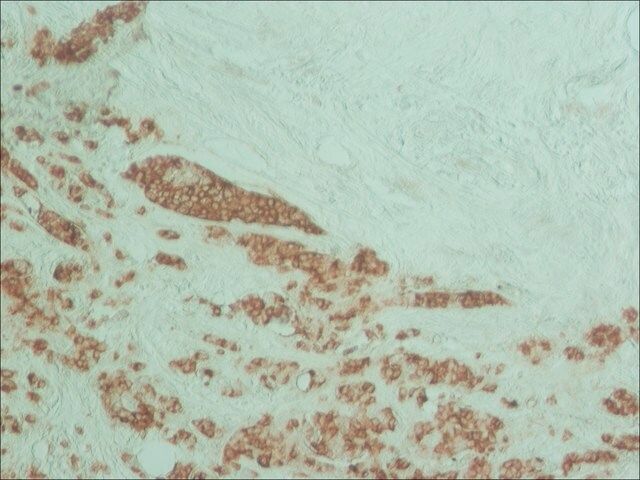您的位置:首页 > 产品中心 > Monoclonal Anti-Episialin (EMA) antibody produced in mouse
Monoclonal Anti-Episialin (EMA) antibody produced in mouse

基本信息
| MDL number | MFCD00211919 |
| NACRES | NA.46 |
| General description【一般描述】 | Monoclonal Anti-Episialin (EMA) (mouse IgG1 isotype) is derived from the GP1.4 hybridoma produced by the fusion of mouse myeloma cells and splenocytes from an immunized mouse. Episialin (mucin-1) is an epithelial transmembrane oncoprotein that occurs in glandular tissues. This oncoprotein mediates ErbB1 receptor transport and subsequently regulates cell survival. Episialin also modulates p53-responsive genes under conditions of genotoxic stress and also co-activates the transcription of Wnt target genes. Overexpression of Episialin has been associated with most human cancers. |
| Immunogen【免疫原】 | human milk fat globule membranes. |
| Application【应用】 | Cell-membrane-associated, mucin-like molecules, such as episialin has a protective function against toxic substances. Data on the effect of episialin on the adhesion properties of cultured cells suggests that episialin expressed at high levels on cells may have a major function in reducing the aggregation capacity of these cells, thus influencing the adherence to various extracellular matrix components by masking adhesion molecules. Monoclonal Anti-Episialin (EMA) antibody is suitable for use in immunohistochemistry (1:200 using formalin-fixed, paraffin-embedded sections of human breast carcinoma), immunoprecipitation and microarray. |
| Biochem/physiol Actions【生化/生理作用】 | Episialin is a transmembrane, high molecular weight, mucin-like glycoprotein (apparent molecular weight of 265-400 kDa) containing many carbohydrate side chains, that are predominantly attached to the molecule by O-glycosidic linkages. It is known as epithelial membrane antigen (EMA), MUC1 and polymorphic epithelial mucin (PEM). The episialin molecule is transmembranous with a relatively large extracellular domain and a cytoplasmic domain of 69 amino acids. The extracellular domain consists mainly of a region of nearly identical repeats of 20 amino acids, the number of which can vary between about 30 and 90 because of genetic polymorphism. The episialin molecule is synthesized as one large precursor containing only N-linked glycans and is immediately proteolytically cleaved while still in the endoplasmic reticulum. |
产品性质
| Quality Level【质量水平】 | 200 |
| biological source【生物来源】 | mouse |
| conjugate【偶联物】 | unconjugated |
| antibody form【抗体形式】 | ascites fluid |
| antibody product type | primary antibodies |
| clone【克隆】 | GP1.4, monoclonal |
| contains【包含】 | 15 mM sodium azide |
| species reactivity | human |
| technique(s) | immunohistochemistry (formalin-fixed, paraffin-embedded sections): 1:200 using formalin-fixed, paraffin-embedded sections of human breast carcinoma immunohistochemistry (frozen sections): suitable immunoprecipitation (IP): suitable microarray: suitable |
| isotype【同位素/亚型】 | IgG1 |
| UniProt accession no.【UniProt登记号】 | P15941 |
| shipped in【运输】 | dry ice |
| storage temp.【储存温度】 | −20℃ |
| Gene Information | human ... MUC1(4582) |
产品说明
| Disclaimer【免责声明】 | Unless otherwise stated in our catalog or other company documentation accompanying the product(s), our products are intended for research use only and are not to be used for any other purpose, which includes but is not limited to, unauthorized commercial uses, in vitro diagnostic uses, ex vivo or in vivo therapeutic uses or any type of consumption or application to humans or animals. |
安全信息
| Storage Class Code【储存分类代码】 | 12 - Non Combustible Liquids |
| WGK | nwg |




